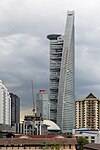Kerinchi Pylon
1999 establishments in MalaysiaBuildings and structures in Kuala LumpurEngvarB from September 2014Malaysian building and structure stubsPylons ... and 2 more
Towers completed in 1999Towers in Malaysia

The Kerinchi Pylon is a lattice-steel transmission tower located near Menara Telekom in Kerinchi, Kuala Lumpur, Malaysia. It was built by Tenaga Nasional Berhad (TNB) in the middle of 1999. At 103 metres (338 ft), the pylon is recorded in the Malaysian Book of Records as the tallest electricity pylon in Southeast Asia. The Kerinchi Pylon differs from other electricity pylons of comparable height, like those of Elbe Crossing 2, because is it not used for a powerline crossing of a wide waterway and that it is just a single structure. It is the tallest strainer pylon in the world, all taller pylons are suspension pylons of long-distance spans.
Excerpt from the Wikipedia article Kerinchi Pylon (License: CC BY-SA 3.0, Authors, Images).Kerinchi Pylon
Lengkok Pantai Baharu, Kuala Lumpur
Geographical coordinates (GPS) Address Phone number Website Nearby Places Show on map
Geographical coordinates (GPS)
| Latitude | Longitude |
|---|---|
| N 3.1169 ° | E 101.6637 ° |
Address
Pullman Kuala Lumpur-Bangsar Hotel (Pullman Bangsar)
Lengkok Pantai Baharu
50614 Kuala Lumpur
Malaysia
Open on Google Maps








